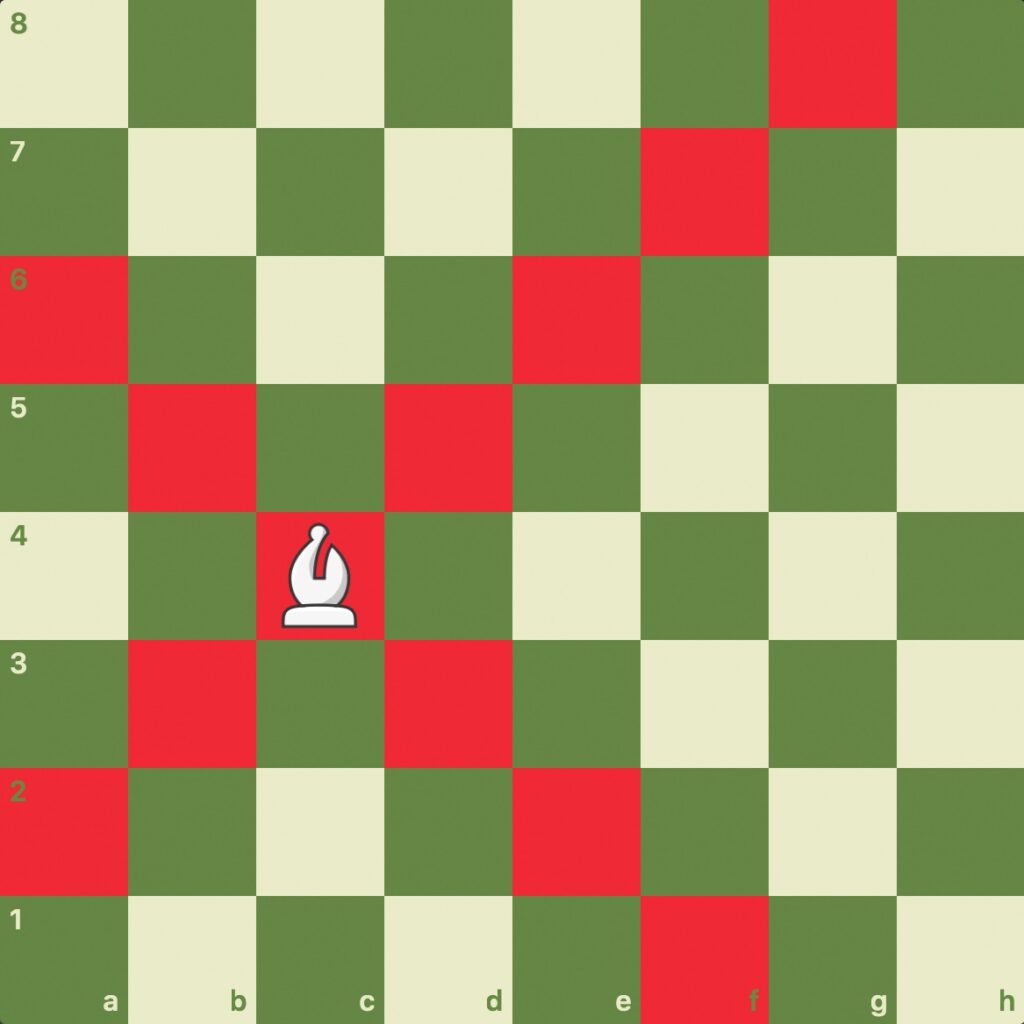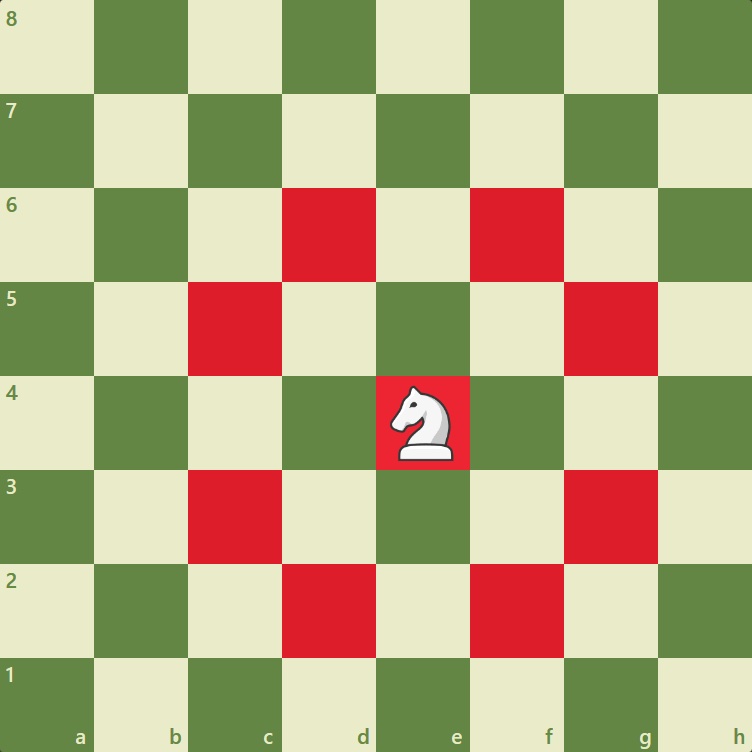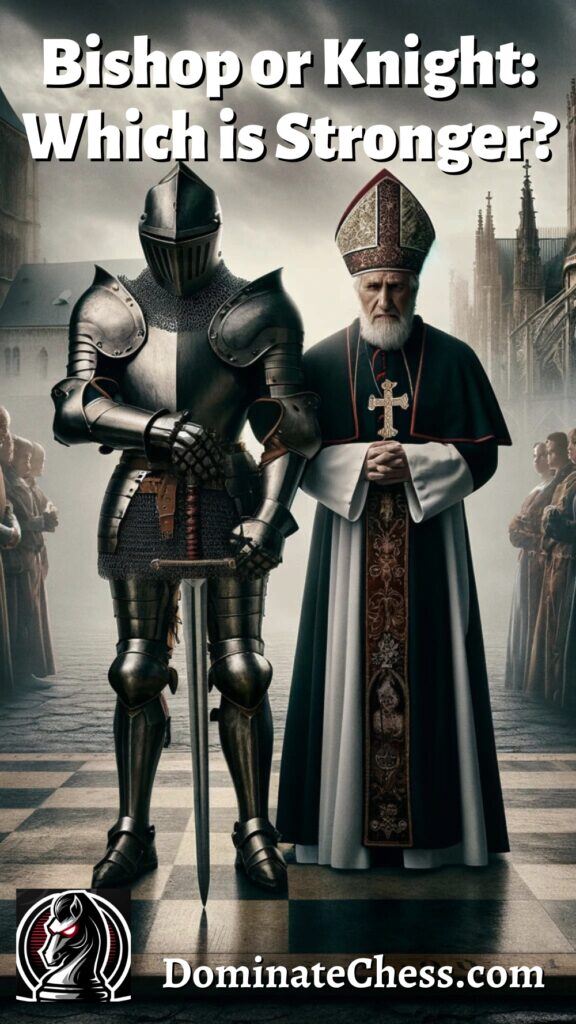It’s a debate that is always a popular topic in the chess forums. When it comes to bishop or knight, which is stronger? These two pieces in particular are more evenly matched than you may think.
Bishop or Knight, Which is stronger?
Most choose the bishop over the knight because of its range. However, the knight can be more powerful because of its unique L shaped attacks and ability to jump occupied squares.
This is a question chess grandmasters have debated for years.
One of the reasons both pieces are given equal value (3 points) is because there are seemingly limitless arguments for one piece being more valuable than the other and vice versa.
You can take a look at a chart showing the relative value of chess pieces here.
Let’s examine this objectively and see what we can conclude.
The video above is a really unique take on determining whether the bishop is stronger than the knight.
At first glance, it looks like a normal chess board. Take a second look and you’ll notice all white’s pieces except for the pawns and king have been replaced by knights.
On the other side, all black’s pieces except for the pawns and king have been replaced by bishops.
It’s actually a really intriguing quick video. I don’t want to spoil it! Check it out for yourself!
Taking a Look at the Bishop
As we all know the bishop moves along the diagonals.

The bishop on the light colored squares can occupy every single one of them, but can never cross over to the dark colored squares.
In the exact same way, the bishop on the dark colored squares can occupy all of those while never being able to cross over to the light colored squares.
The bishop is also a long range attacker, only limited by the spaces on the board itself.
However, the bishop can’t jump over occupied squares to make an attack. Because of this, if there are a lot of pawns on the board, the bishop’s attacks can be limited.
Taking a Look at the Knight
The knight as we all know has a very unique L-shaped movement on the chess board.

If you take the bishop’s diagonal movement and pair it with a rook, you basically get the queen.
However, no other piece even comes lose to the unique L-shaped attack of the knight. A knight can be hard to defend because of the fact that it can jump over pieces and basically attack any square on the board.
Surrounding your king or even proper castling could thrwart any attack being made by a bishop, not so with the knight. Your king could be surrounded by pieces and still be put in check or even mate by a well placed knight.
While bishops can attack from long range, knights must attack up close and personal. This means it can take more moves to get your knight into an attack position.
It’s important to note that a knight on the edges of the board is much, much less of a threat than when it’s closer to the center of the board.
The number of squares a knight can attack from the center can be double what they are on the periphery.
Further, a post knight stuck in the corner can be devastatingly handicapped in its attack.
Knights and Bishops Working in Pairs
If you’re playing an opponent who is good with his or her bishops, they can be very formidable as an attack combo.
Even though a bishop is valued at 3 points, some argue that having both bishops together can be valued as high as 9 points, equaling a queen.
However, in my opinion, the second you capture one of your opponents bishops, their threat is drastically minimized.
Why?
Because a solo bishop can only occupy half the squares on the board. You can literally stay away from them fully protected by sticking to the squares where it can’t attack.
If you’re down to one bishop it’s a good strategy to use your pawns to occupy the colored squares that your captured bishop was able to control.
This way you at least maintain some control on those squares that your lone bishop can’t occupy.
While the bishops can be devastating working in pairs, the knight doesn’t gain the same advantage with its pair. But this also means it not any less of a threat running solo when one is captured.
Paired knights can protect each other well, and you see this often enough. There are some quite spectacular checkmates that can happen using both knights, but these are very rare to actually witness.
More often than not, one of the knights is sacrificed early to mid-game, usually taking out a bishop, and then the remaining knight attacks on its own.
Bishops and Knights, An Even Trade?
As mentioned at the top of the post, when it comes to “value” of pieces on a board, both the bishop and knight have a value of 3.
So is it truly an even trade if you take out a bishop with your knight and vice versa? It truly depends on the player.
Some grandmasters play heavily with their bishops. Some prefer their knights and attack furiously with them.
The Grandmaster Bobby Fischer considers the bishop to actually have a value of 3.5.
But it’s important to note that you shouldn’t just take a piece based on point value.
You have to consider the game being played on the board.
- What kind of attack are you making at that point in the game?
- What kind of defense do you have in place?
- What is the placement of the piece your attacking with respect to the one you’re about to trade?
Remember, pieces closer to the center of the board are much more of a threat than pieces on the edge.
You truly have to consider the overall game to that point and how you’re playing offense and defense to determine if your bishop or knight is actually more valuable than your opponent’s bishop or knight.
Never trade pieces purely on point value.
Popular Opinions
The Chess forums online are pretty much split down the middle when it comes to whether the bishop is stronger than the knight and vice versa.
There are countless examples of end games, mid games, and opens where a player will insist that the knight is the stronger piece.
Inevitably that will be followed by another player giving example after example of bishops annihilating their adversaries and being the stronger piece.
Personally, I’ve always had issues defending the knight.
Early on I would make it my priority to take out my opponent’s knight’s for that exact reason. I’d trade my bishops for their knights and then start out my attack.
To be honest, that’s not a very sound approach to playing, but since they were my weakness, I was determined to get them off the board.
Now, as a more experience player, I take into account what is going on in that singular game. I don’t mindlessly sacrifice my bishops for knights.
Final Thoughts
While each have unique pros and cons, an argument for the value of one over the other can’t really be made definitively.
What do you think? Which is your favorite between the bishop or the knight? Which piece do you feel is stronger? Which do you have more difficulty defending? Let me know how you feel in the comments section below! I love reading your questions and comments and I always reply back.



I’m “relatively” new to learning about different strats in chess… A buddy of mine got me pretty deep into it and I still have not been able to get the upper hand… He brought up quite a few errors I’ve made with both Bishop and Knight plays, where the trade-off wasn’t worth my play, so came across your post while looking at how to enhance my own plays.
I think I’ll try to switch up some of my plays and focus more on Bishop pairs and try to keep Knights at bay for later on in the match… I haven’t even considered different plays combining the Bishops to outplay, but you’re totally right.
Cheers! I’ll continue reading some of your other posts and hopefully dominate my friend soon with the info here! 😂 🤝
Glad you’re enjoying the site! Thanks for the comment!
I remember as a kid that I always ended up sacrificing my knights in order to get the other player’s bishops and I was never sure if that was a good trade.
This article is very informative and I will certainly apply what I’ve learnt here on my next game!
Some people argue that the pawns are the most important piece, do you agree?
If you use your pawns correctly they can definitely factor into positional advantage, that’s for sure. Keeping your pawn structure intact while attacking your opponent’s is a great strategy.
Ok, so I have to say I think my favorite piece overall, of the two, is the Knight. However, as you mentioned, the long drive that the bishop does, has helped me out from time to time, when I have played.
That said, I’ve never been one to enjoy Chess as much as I should. I liked watching the Chess match of ALL Bishops and ALL Knights. I Actually was shocked to see the Bishop’s Win (Sorry for the spoiler alert)!
Would you think if they re-invented chess, it would be more popular to play? What would the pieces be called, and which directions would they move?
Great article!
Thanks for the comment man!
My interest in the game of chess started when I learned about our very own Eugene Torre who became not just the first Filipino but also the first Asian to qualify for the title of Grandmaster.
I thought chess was a boring game but it’s actually the opposite. That’s why I was almost on the edge of my seat while watching the video that aimed to determine which of the Bishop or Knight is stronger. That was fun!
While the bishop and the knight were each given a 3-point value, it will still depend on the player how to utilize them to their advantage and win.
Thanks so much for chiming in! I appreciate it!
I’m still a beginner at chess and look forward to becoming a professional player. I’m getting as much information about playing chess as possible. My favorite piece overall of the two is the Knight. Whenever I want to take my opponent’s Bishop, I have to sacrifice my Knight. I don’t know when I’ll be able to do that without sacrificing my Knight. After reading your article, I realized that they have the same value in the game. In my next game, I will use the points you mentioned and won’t sacrifice any of them anymore.
Don’t focus so much on taking individual pieces arbitrarily. Instead just take the pieces that are a threat in that specific game. Your play will be more balanced that way. Thanks for the comment!
Hey,
These articles on chess are so interesting. They are even more interesting for my nephew who is turning into a chess prodigy.
I am going to share this article with him and I am sure he will learn so much from you that will hopefully help him in his chess games.
Thank you for sharing and keep up the great work.
All the best,
Tom
Glad you enjoyed it!
Hi Eric,
You have presented a very interesting topic here, and made me think about this for awhile. I must admit I found pros and cons with picking either piece. I agree with the movement of the knight and ability to jump over pieces to be of possibly higher value. The bishop is confined to the one color and is possibly easier to trap into capture. Both pieces can be forced into capture with a few other remaining pieces such as rooks and queens, not to mention the lowly pawn can also effect a capture as well.
I guess I am split, but lean towards the knight. I try not to lose either one! Thank you for posing this question for me to ponder!
Glad you enjoyed the post! Thanks for the comment!
OK – first I am not even close to a novice when it comes to Chess, so I was very intrigued by this article. The video helped me understand the information in the article. I appreciated that and the detail that went into the video. I was able to follow along. To be further honest, it made me a little curious to see if I could manage this game. I know it takes a lot of practice and understanding, but I liked your thinking behind who was more powerful!
Yeah I thought that video was a really unique way to show how bishops and knights fare against each other. Thanks for the comment!
I found your article on chess very interesting. I’ve always felt bishops and knights were practically interchangeable as far as value.
I still have more to learn to understand chess better and my question is what did you do to truly become better at the game? Was it continuous educating or constant playing or both?
The best way to get better is constant playing. And when someone dominates you, take note of the strategies they used and then use them later against other players. 🙂 Thanks for the comment!